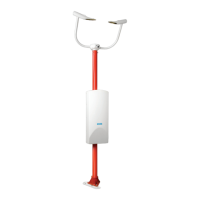Chapter 3 ________________________________________________________________ Installation
VAISALA ________________________________________________________________________ 21
- The receiver and transmitter optics should not point towards
powerful light sources or, in bright daylight, towards reflective
surfaces such as bodies of water. It is recommended that the
receiver point North in the Northern hemisphere and South in the
Southern hemisphere. (The transmitter and receiver heads can be
identified by first locating the surface temperature probe, which is
closer to the transmitter.) The receiver circuit may become
saturated in bright light, in which case the built-in diagnostics will
indicate a warning.
- The transmitter and receiver should face away from any obvious
source of contamination, such as spray from passing vehicles.
Excessive contamination is automatically detected by the sensor.
- There should be no bright flashing lights near the sensor or in the
receiver's field of view.
- If a Background Luminance Sensor is to be installed it needs a
clear view of the sky in its preferred viewing direction (normally
North in the Northern hemisphere and South in the Southern
hemisphere; see section LM21 Background Luminance Sensor on
page 57).
3. Power supply and communication lines must be available.
- When siting the FS11 sensor, consideration must be given to the
available power supply and communication lines, as this
influences the amount of work and accessories needed, and
hence the actual cost of the installation.

